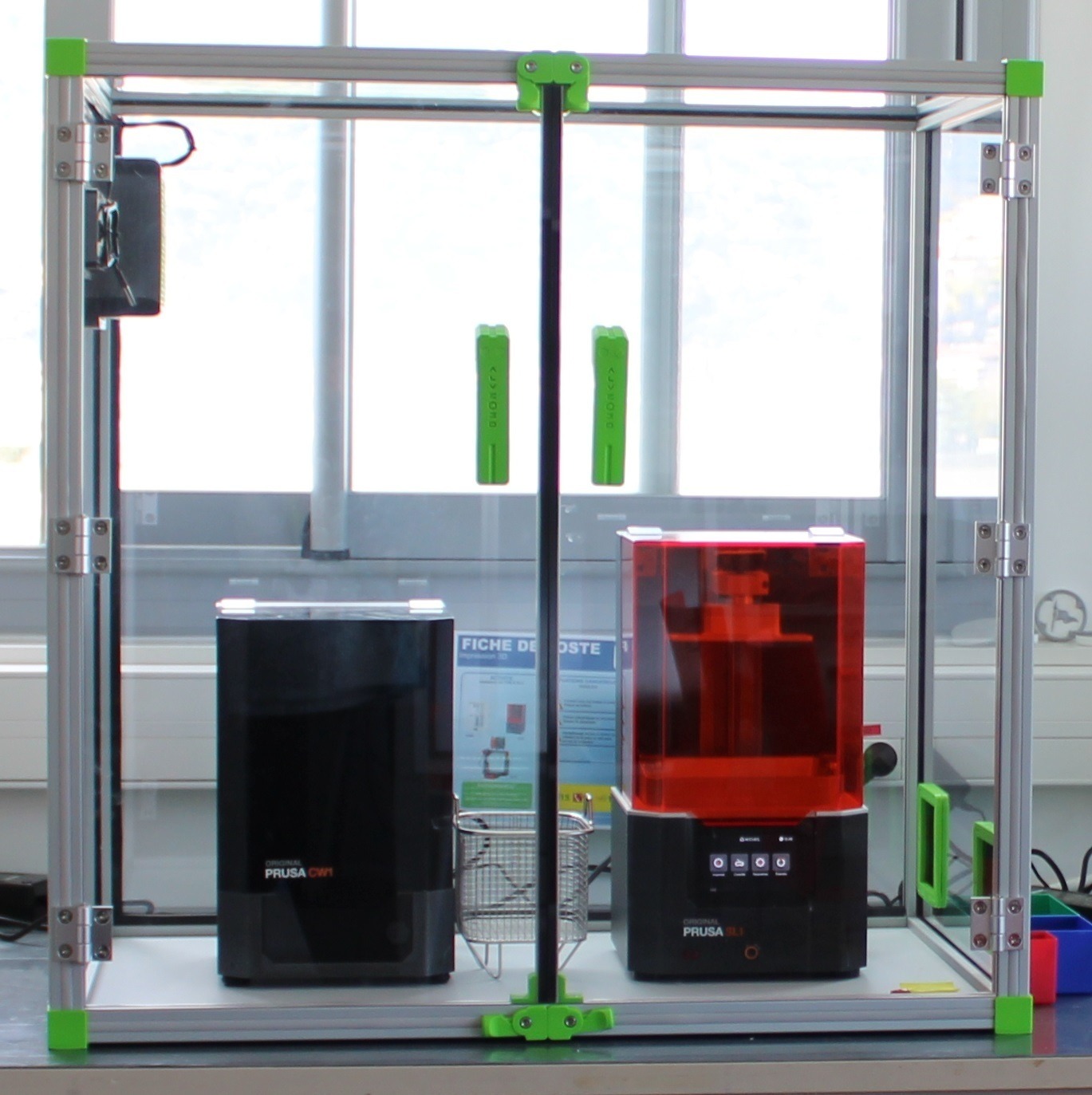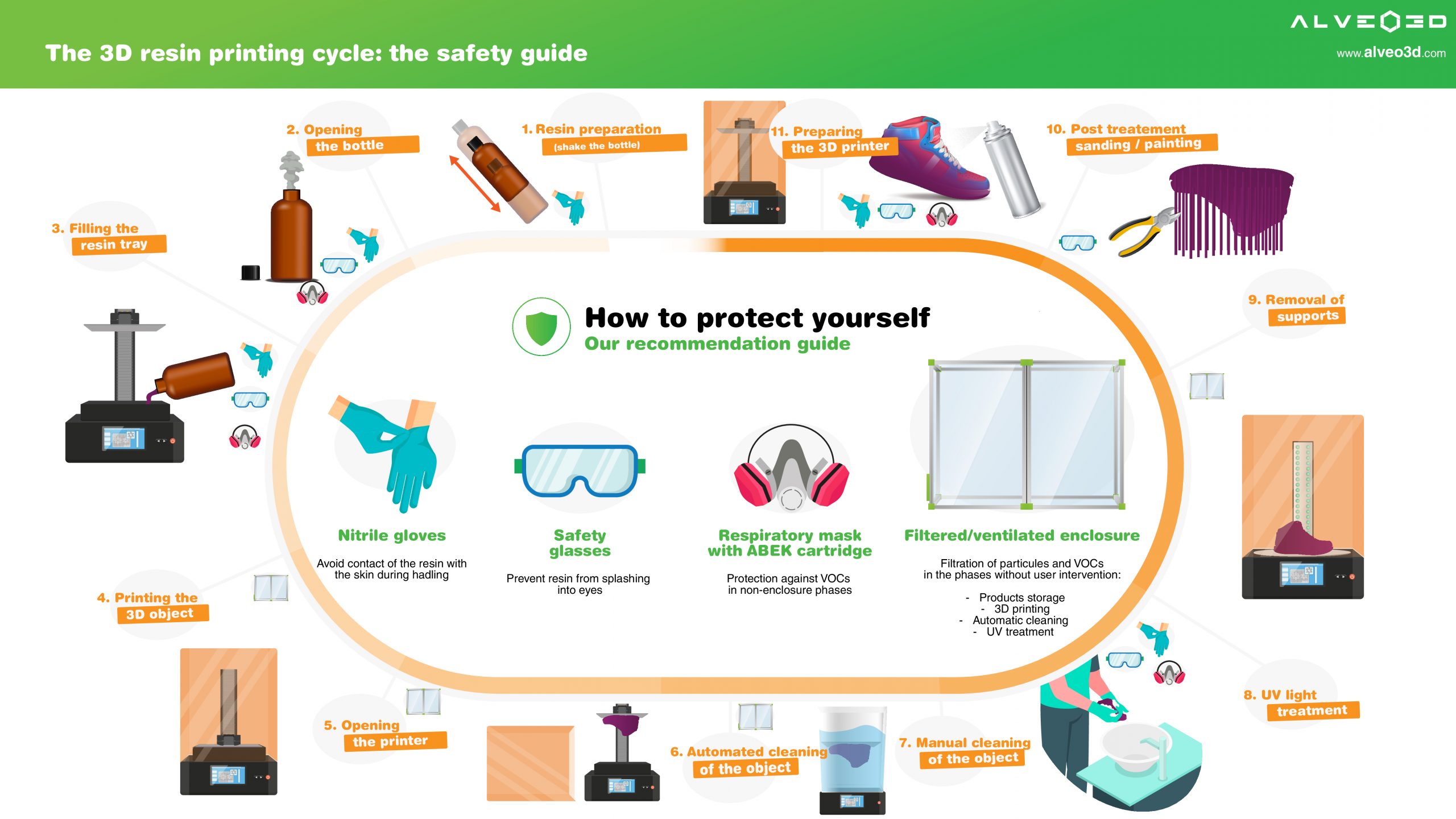I. Introduction
3d printer resin is a game-changer, opening doors to incredible detail and precision. But we often ignore 3D resin printer safety, it plays a huge role in this technology. That’s why Alveo3D comes here. We’re passionate about guiding you towards a safe and rewarding resin printing experience.
From essential safety tips to expert advice and budget-friendly solutions, we’re here to help you shape your resin printing journey in 2024.

II. The Best solution for 3d printer resin safety
1. CUSTOMIZED ENCLOSURES
Designed specifically for resin printers and their specific requirements. These enclosures are designed to accommodate the height of the printer and post-processing equipment, and provide options for opaque panels to shield from external radiation.
When it comes to ventilation, options include external air exhaust or AlveoPRO filtration to address high concentrations of volatile organic compounds (VOCs). The enclosure is designed to be watertight, with a customizable filtration system for efficient air management. They’re big enough inside so you can easily see what’s happening during printing, and some even have built-in cleaning systems.
They’re made with tough materials like Polycarbonate clear plastic and fire-resistant laminate, and they have strong metal frames to keep everything sturdy. Beside of that, they include special panels that help prevent UV light from affecting the print quality, which is really important when working with resin printers.

1.1. Why is the Alveo3D enclosure unique among its competitors?
Alveo3D’s expertise ensures that the protective enclosures offer a superior level of security throughout the additive manufacturing process.
The enclosure for 3D printers stands out from its competitors because of:
- Exceptionally rigid and lightweight structure.
- Constructed with aluminum profiles for a sleek, modern look.
- Features a spacious front door made of polycarbonate for easy and safe access to prints.
- Allows for continuous visual monitoring of prints throughout the production process.

1.2. Which type of 3D printers is the aluminum enclosure suitable?
Our aluminum enclosure is designed to accommodate a wide variety of 3D printers, including some of the most popular models on the market. Whether you’re working with well-known brands like MakerBot, Ultimaker, Prusa, or Creality, our enclosure’s flexible design ensures it can support your printer. This versatility makes it an ideal choice for enhancing the safety and efficiency of your 3D printing setup, regardless of the specific printer you own.

2. Additional solution for Professionals
2.1. AlveoPRO
The AlveoPRO system presents a versatile and adaptable solution for managing potential air quality concerns related to resin 3D printing. Its extendable suction tube offers flexible positioning for efficient fume capture.
An LCD screen facilitates remote control of fan speed and a filter life timer, allowing for customization based on specific needs. Additionally, an integrated safety system provides prompt alerts for potential malfunctions or filtration issues, ensuring timely intervention. Regularly scheduled firmware updates via the USB port further enhance system performance and optimize user experience.

2.2. THE CYLINDRICAL CARTRIDGE
While undergoing testing, the cylindrical cartridge demonstrates impressive results, especially in its effectiveness for air filtration in resin 3D printing. Its activated carbon composition, made from specific coconut shell granules, enables the neutralization of health-hazardous VOCs like styrene and formaldehyde, effectively filtering the vapors emitted by the resin during the 3D printing process.

III. The Cheapest solutions
1. The Printerbox
Tired of smelly resins and worrying about fumes? The PrintBox for resin 3D printers offers the perfect solution, combining safety, efficiency, and convenience in one sleek design.
Here’s what makes PrintBox stand out:
- Breathe Easy: No more harmful emissions! The built-in P3DL HEPA filter with activated carbon traps nanoparticles and VOCs, ensuring clean air in your workspace.
- Crystal Clear View: Monitor your prints in real-time through the sturdy 4mm PMMA dome, without worrying about scratches or fogging.
- Print Anywhere: Available in three sizes, PrintBox easily fits various printers and printing environments. Its lightweight design with handles makes it portable and effortless to move.
- Universal Compatibility: No need to worry about compatibility issues. The universal cable passageway ensures a secure connection without air leaks.
- Advanced Control (Optional): Upgrade your PrintBox with the V2 control board for even more precise filtration management.

I orderer a PrintBox because it looked exactly what I was looking for. But my expectations exceeded! I normally print functional parts using ABS-like resins, and usually those tend to have a noticeable odor. The enclosure works like magic and I can’t smell it anymore. And if it’s removing the odor I’m confident it is also removing all the nocive resin byproducts.
The shipping was fast and they answered all my questions before the purchase. I’ll be buying more from Alveo3D in the future for sure.
2. THE P3DL FILTER
These are the main reason to choose the P3DL filter as a solution for resin printing safety:
- Tailored Filtration: Specifically designed for resin printing, it effectively targets pollutants with HEPA 13 fiberglass media and activated carbon, thereby reducing the emission of nanoparticles and VOCs throughout the resin printing cycle (50mm thick layer of activated carbon for potentially better absorption of VOCs)
- PrintBox Compatibility: Engineered to work seamlessly with PrintBox enclosures, ensuring effective odor reduction and emission control.
- Durable and Efficient: Built to last, it offers long-lasting performance in eliminating odors and harmful emissions.
- Easy Installation and Maintenance: Compact and lightweight design allows for quick installation and replacement, ensuring hassle-free operation.
- Affordable price: With only 30 euros, you have to replace it after 6 month of use.

3. M100 – HEPA 14
The M100 HEPA filter is a high-performance air filter designed specifically for use with the AlveoPRO air filtering system for 3D printers. HEPA (High efficiency particulate air) filter category H14 99,995% for the most penetrating particle size (MPPS) 0.3μm combined with activated carbon granules 1-3mm mesh size.

IV. The Latest Safety Guide for Resin 3D Printing
3D printing resin safety precautions
Remember, these resins behave like chemicals, so be mindful:
- Protect your skin: Think gloves! Always wear them when handling resin to avoid irritation or allergic reactions.
- Don’t breathe in the fumes: Keep your workspace well-ventilated and consider using a respirator, especially when dealing with large prints or sanding cured resin.
- Keep things clean: Spills happen, but clean them up promptly with the right solvents, following the manufacturer’s instructions.
- Store it right: Seal those resin containers tightly and keep them away from heat and light when not in use.
- Be mindful of your eyes: Avoid eye contact with uncured resin and wear safety glasses when pouring or handling it.
- Dispose responsibly: Don’t toss resin down the drain! Check with your local authorities for proper disposal methods.

FAQ
How to deal with resin printer fumes ?
Here are some recommendations:
- Separate space: Ideally, keep your printer in a well-ventilated area, such as a garage or workshop. This insulates the fumes and protects your living space.
- Air extraction system like Alveopro: install an extraction system to evacuate the fumes directly outside. This is a very effective solution.
- Air Filtration Enclosure: Consider a ventilated enclosure for your printer. This traps the fumes inside the enclosure and allows evacuation by a fan. The carbon filter can help capture and remove resin particles from the air.
And don’t forget your Personal Protective Equipment (PPE):
- Wear gloves, goggles, and a mask: This protects your skin, eyes, and respiratory system from direct contact with resin and its vapors.
What happens if I touch resin?
Touching untreated plastic, especially some types, can cause skin burns and blistering. This happens because the chemicals in the plastic react with the skin, causing irritation and damage.
Remember:
- Always wear gloves and safety glasses when handling resin.
- Avoid skin contact as much as possible.
- Wash your hands thoroughly with soap and water after handling resin, even if you were wearing gloves.
- If you experience any irritation, allergic reaction, or eye contact, seek medical attention immediately.
- Always consult the manufacturer’s safety data sheet (SDS) for specific information and precautions regarding the particular resin you’re using.
How safe is 3D printing resin?
Liquid resin used in 3D printing can be hazardous to your health if not handled properly
Potential hazards:
- Health: Resin contains chemicals that can be harmful if inhaled or absorbed through the skin. These chemicals can irritate the eyes, skin, and respiratory system, and in some cases, cause allergic reactions or even more serious health problems with prolonged exposure.
- Fumes: The printing process releases VOCs (volatile organic compounds) that can have unpleasant odors and potentially irritate the respiratory system.
- Fire: Some resins are flammable and can be ignited by heat or sparks.
Do you need a mask for 3D printing resin?
Recommendations:
- Always prioritize adequate ventilation. This is the most important step in minimizing risks.
- If ventilation is limited, wearing a mask is highly recommended. Choose a respirator with appropriate filters (such as P3DL HEPA filter with activated carbon) designed for organic vapors.
- Follow the manufacturer’s safety data sheet (SDS) for your specific resin. The SDS will provide detailed information about its composition, risks, and recommended safety precautions.
- Consult a healthcare professional if you have any concerns about respiratory issues or allergies related to resin.
Do you need ventilation for a resin 3D printer?
Yes, ventilation is highly recommended for a resin 3D printer.
Health Risks:
- Volatile Organic Compounds (VOCs): Resin emits fumes containing VOCs, which can be harmful if inhaled over time. These can cause irritation, dizziness, and even respiratory problems.
- Allergic reactions: Some people are allergic to resin components, and exposure can trigger skin or respiratory reactions.
Other reasons:
- Odor: Unmitigated resin fumes can have a strong, unpleasant odor that can permeate your workspace and surrounding areas.
- Print quality: Proper ventilation can help maintain consistent printing temperatures and humidity levels, leading to better print quality.
Ventilation options:
There are several ways to achieve proper ventilation for your resin 3D printer:
- Open window: While not ideal, opening a window can help dilute fumes in well-ventilated spaces.
- Dedicated ventilation system: A dedicated ventilation system directly connected to your printer enclosure effectively removes fumes and odors. Options include:
- AlveoPRO: 3d printer air extraction system will remove fumes directly outside.
- HEPA filter: Captures particles and VOCs within the enclosure.
Considerations:
- Enclosed printer: Using an enclosure is highly recommended for resin printing, even with ventilation, as it further minimizes exposure to fumes and odors.
- Local regulations: Check local regulations regarding VOC emissions and ensure your ventilation system complies.





